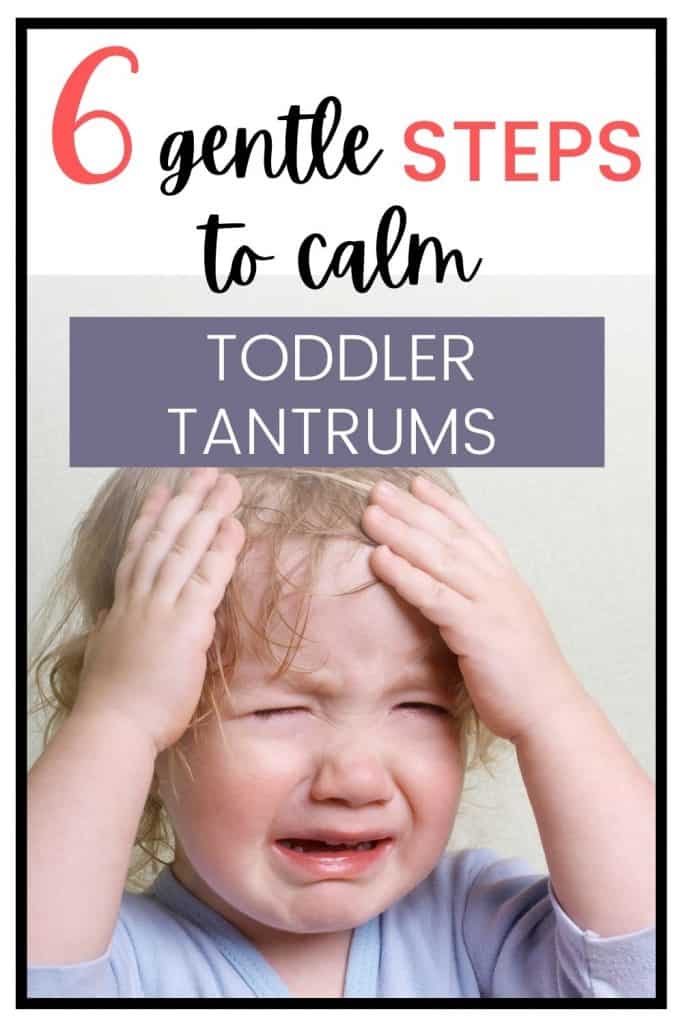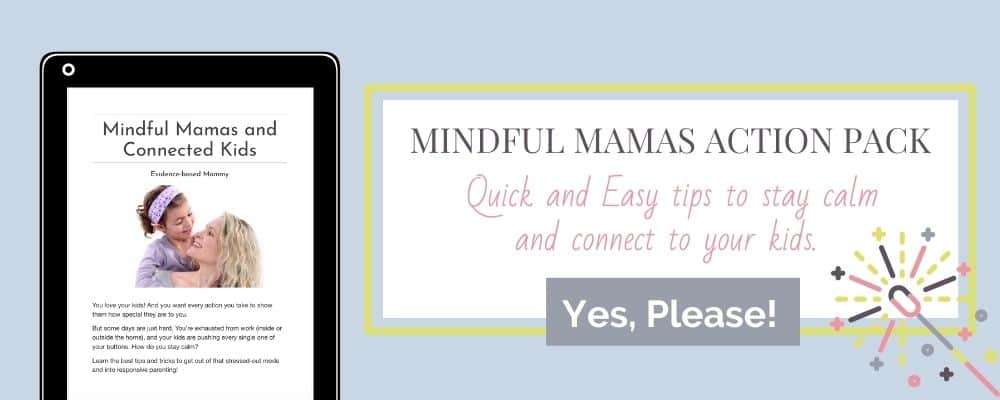We’ve all had that moment out in public. How do you do gentle parenting when your child has a tantrum (and you feel like everyone is staring at you in the middle of the grocery store)?
Or maybe you’re running late for an appointment, and of course your three-year old picks that day to lose his mind about not getting to wear snow boots in July.
It can be so stressful when your young child falls apart, especially whether you are in public or you just don’t have time to handle a meltdown.
Are you desperate for gentle parenting strategies to calm toddler tantrums? Or perhaps your preschooler (or older!) is having frequent meltdowns and you need help dealing?
After all, the mindset of just. make. it. stop. isn’t enough. You want to help your child grow through these experiences, and heck, maybe for you to have some personal growth too. I asked my friend Megan MacCutcheon, LPC, PMH-C, exactly what happens during a tantrum, plus what you can do to stop them. Here are some gentle parenting strategies to help you calm down a child having a tantrum.

Table of Contents
The science of what happens during a tantrum
Have you ever heard of the fight, flight, or freeze response? The human brain is divided into different sections: The frontal lobes, or the “thinking brain,” is the part of the brain that is involved in thinking, reasoning, problem-solving, and verbal expression. The limbic system, often referred to as the “mammalian brain,” handles non-verbal emotions and experiences. And the brainstem, the “reptilian brain,” manages the autonomic nervous system and functions such as heart rate and breathing.
When we are in a state of distress, panic, or intense fear, the frontal lobes go “off-line” so that the reptilian brain can work instinctively in overdrive to protect us. This biologically wired system can be best understood when we think back to our cavemen ancestors:
Imagine a caveman out in the woods, searching for food. When he is approached by a threat, for example a tiger about to eat him, his frontal lobes go off-line so his brain can focus on running away and getting out of the danger zone. This is the body preparing for fight, flight, or freeze.
It’s kind of the same thing for a toddler in a tantrum. When a toddler has become so emotionally overwhelmed by whatever event caused the meltdown, his frontal lobes shut down as the other parts of the brain take over.
That’s why it’s nearly impossible to reason with a toddler during a tantrum. His/her frontal lobes are offline. Reasoning and communicating effectively are impossible and there is no capacity to absorb new information.
Teaching mindfulness skills outside of moments of tension and tantrums is so important. It’s also important to practice them often so they become second-nature. When they can be done without involving a lot of thinking or remembering, they become much more effective in alleviating stress in the moment.
RELATED: Teaching mindfulness to toddlers – 5 mindfulness activities
How to prevent tantrums in toddlers
You can greatly reduce how often you deal with tantrums just using a few simple tips. Check them out below.
1. Make sure to have “floor time” with your child.
Spend some time with your child (preferably daily) just doing what he wants to do. It’s called floor time because you’ll probably need to actually get down on the floor with him!
Does he want to pretend that he’s a superhero and you’re the villain? Let him beat you. Does he want to play blocks? Let him direct you on exactly where to put the cube (even if it doesn’t look right to you!). Floor time makes sure that your child feels connected to you (and therefore more secure and less prone to tantruming).
RELATED: Toys that encourage free play for kids
Plus, if you let him call the shots, it gives him a chance to feel in control!
Think about it: The times you absolutely lose it, it’s because you’re angry or afraid because you feel like you’re totally out of control, right? Most likely, you have tons of stuff going on that you feel like have spiraled beyond your control in that moment.
Kids are the same way! Just having some time where he feels like he can have things go his way in a safe environment will make him less likely to fall apart when you really need him not to.
2. Find a fun way to get your kid to cooperate.
It’s much easier to get your kids on your side when you use a playful tone. And there are lots of fun ways to ask your child to do what you need them to do. But wow, it’s so hard to do that when you’re already frustrated yourself!
That’s why I created the Mindful Mamas and Connected Kids Action Pack! Sign up for eight FREE pages of strategies you can implement immediately, including printable Mama Mantras (to place around the house!), the six step Tantrum Tamer process, and Playful Prompts for Cooperative Kids. Join here to get your toolkit today!
3. Have a daily routine.
We’ve all heard it: Children thrive on routine. The more she knows what to expect, the less likely your child is to feel out of control (see Point 1), and the more she’ll be able to cope with the day.

Of course there’s going to be days when you’re off your routine; that’s life! And messed-up routines are especially likely during holidays or travel. On top of that, if you’re dealing with holidays or travel, you’re probably going to see family, which means you’re a little extra keyed-up about your kids being perfect little cherubs. So what do you do?
Explain the break in routine to your child. Yes, even if she’s only fourteen months old (or younger)! Just say something simple like, “We’re going to wake up early tomorrow morning. We’ll cuddle for a little bit like we always do, and then we’ll get up, get ready, and drive to Nonni’s house. We will stay there all day and all night, and we’ll get to play with Nonni!” And little reminders throughout the day help too. “Remember, we sleep at Nonni’s house tonight, and then we’ll wake up and play with her some more, and then we’ll go back to our house.”
4. Pre-empt your kid being hungry.
It’s not just mommas who get hangry. Try to have regular meal times with snacks throughout the day for little ones. Not sure what to cook or have on hand? Check out my post about cheap and nutritious foods here!
RELATED: Cheap, budget-friendly foods!
5. Keep your child’s sleep routine regular.
Just like how you’re more emotional when you’re tired, so is your kid. Try to keep that routine going with a reasonable bedtime and include the appropriate number of naps for your little one. Naps on the run are better than nothing, but if you can get home for rest time, that’s best.

6. Teach your child mindfulness techniques
While this isn’t as much of a quick fix, the sooner you start teaching mindfulness to your toddler, the sooner they can start using these skills to regulate their own emotions.
Luckily, I have a whole article on teaching mindfulness to toddlers.
RELATED: Teaching mindfulness to toddlers – 5 mindfulness activities
Should you put your child in time-out for throwing a tantrum?
Have you ever heard that you shouldn’t give a tantrum attention? That’s not true!
While it’s true that you shouldn’t give in to a tantrum (as in, you shouldn’t buy a candy bar to get your kid out of a puddle in the grocery aisle), you need to support your child through a tantrum.
Time-out is not a good way to support a child through their big feelings. It gives the message that you shouldn’t need help to process emotions, and let’s be honest, how many of us have issues from that exact same belief today?
Instead, you should practice time-in. I explain more below.
Gentle parenting for tantrums
Tantrums are just part of life with kids (especially younger kids). The real question is, what do you do to handle the tantrum in the most effective way possible?
1. Get yourself calmed first.
Some of us get really triggered when our toddler has a tantrum. Maybe because you weren’t allowed to express your feelings as a child, or maybe just because you’re uncomfortable with unpleasant emotions, but your stress will not help your child calm down.
RELATED: Positive parenting vs. spanking – the research
And if meltdowns really stress you out, I know that it’s so hard to calm down. But that’s the great part of being a parent, is that you get lots of practice at personal growth. Sometimes when I have a kid falling apart (or two, or even the whole trifecta if I’m lucky),
I STOP before I do anything…
and just close my eyes.
Even if I literally have a kid clinging to my legs and wailing. I just close my eyes and take a deep, calming breath or two.
RELATED: How mindfulness can make you a better parent
I then think through how I’m going to handle the situation, and tell myself something that lets me feel some sense of control (back to Point #1 again). A favorite mantra (from this person) is, “This is not an emergency.”
Which is true! No one is bleeding, the house isn’t on fire, there’s just some loud creatures who come up to knee-level surrounding you. They aren’t really hurting you. And hey, if someone is bleeding, your panic won’t fix it.
Another favorite affirmation from a book I recently read is “There is nothing wrong in this moment.” And again, if you take time to think about it, it’s really true! Like, your kids are yelling, but that’s nothing you can’t handle. You won’t be able to effectively help your child calm down until you learn how to calm yourself down.
I’ll be honest, if I had stumbled across this post three and a half years ago (through some weird tear in the space-time continuum, I guess), I would have read this section and would have been indignant.
In fact, pissed would probably be the more accurate description. Oh sure, just stay calm, this whacko says. There’s nothing wrong, she says. Have you been in my house?! Have you SEEN how stressful it is?!
If you’re feeling that way when you read this, I soooo get you. Being able to handle things this way takes practice. Like years of practice, and sometimes I still blow it. But start trying today, and you and your child will be better for it.
How to calm a child down
Now that you’ve calmed down, you’re ready to help your child through her tantrum. Here’s how to do it.
2. Get down on your child’s level.
Towering over her telling her to calm down isn’t going to help. Kneel down to where your child is. She will likely be too upset to look you in the eyes, but your presence will help.
3. Empathize while not giving into your child.
Sometimes, your kid is just crying because he’s overwhelmed. Other times, he wants something that he can’t have. You can agree with your child’s feelings and still not give them what they want. “Oh Budrow, I know you want to play with daddy’s ear buds. They’re pretty neat, aren’t they? They are for daddy though, so I’m going to put them back up on the counter.”
And don’t let them hit you or otherwise hurt you. If that starts happening, say, “We do not hit. I’m going to stay over here (not out of the room, just away from the flying hands) until you stop hitting.” If they’re really little (like one or two), you can instead gently hold their hands down so that they don’t hit while still holding them.
Does this reaction sound impossible? Back to Step #1.
4. Be present.
If your little one is so lost in screaming and/or crying that they can’t hear you, just wait them out. You can sit there with them, whether they’re in your lap or just a little a way, and be a patient, calm presence in the middle of their storm.
When my oldest was two and three, she would throw epic tantrums. Like really epic. I would hold her and she would fight against me and scream. Not always, but often I was able to stay calm and tell her I was there for her, all while she continued fighting like this.
After after these huge meltdowns, if I responded calmly, she would be a lot easier to deal with than she had been for days! Believe it or not, the struggle that toddlers give you during a tantrum actually helps them release pent-up emotions so they don’t stay bottled up.
By the way, staying present with your tantruming child isn’t “rewarding bad behavior.”
To give some context to this statement, imagine you were really upset about something (to put it on the proper scale, it would be a situation like having a feeling like your job is threatened or a serious fight with your SO). Let’s say that when you tried to express themselves to a friend, she just told you, “I’m going to ignore you until you calm down.”
That’s so not okay, right? It’s not okay to tell your child that either.
And it’s true, getting the green sippy cup instead of the pink is not the same scale as the adult situations I described above. But your child doesn’t have the experience to know that yet. To him, everything is still make or break. That’s why he needs your help and empathy.
5. Teach your child coping strategies.
Ever since my oldest was about two, I’ve been teaching her to close her eyes and breathe (pretty much the same as you do for yourself in Step #1). I say, “Let’s take some nice, slow, deep breaths to help you calm down… Breathe in (inhale myself), breathe out (exhale myself). Breathe in, breathe out,” and so on until she actually starts to calm down.

Now at five, she occasionally uses this strategy without my prompting if she feels stressed. It seems to really help her. And even if your kid is older, there’s no time like the present to start helping her cope!
You can also have a designated area for your child to use to settle down. We’ve created a “calming corner” with favorite books, sensory toys, and cozy blankets and pillows for our kids to use to settle down.
RELATED: Creating a calming corner for kids
6. Talk through emotions.
When my little younger daughter pitches a fit (a good Southern expression, there), I take her to a quiet, private space in a different room and tell her I’m going to let her “get her mads and sads out.” It helps to give children a name for what they’re feeling.
Even with a younger toddler (around 1 or 2), you can say, Oh! you sound so frustrated! or Oh, that makes you so mad! or whatever it looks like he’s feeling. Start when they’re little bitty, and by three they’ll start using the same language.
When you’re handling a 2 year old tantrum (or even older), get to the underlying emotion. Often, when we feel angry it’s hiding a fear or grief. You’re afraid you’ll never get to play with the truck your brother has. See how different the effect of that sentence is from You’re so mad your brother has your truck?
Once again, have older kids? No time like the present.
The hardest part of dealing with tantrums
The hardest step of dealing with tantrums? Keeping yourself from getting triggered. If you can do that, the rest of the steps will be easy!
That’s why I’ve developed the Mindful Mamas and Connected Kids Action Pack. Get your free copy, full of insights and quick tips on how to center yourself and calm your kids. I look forward to hearing from you!


